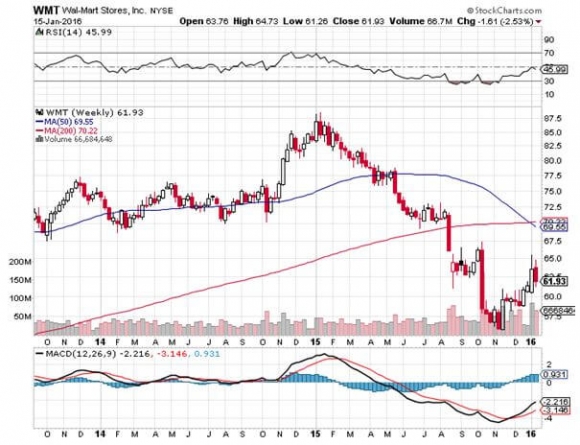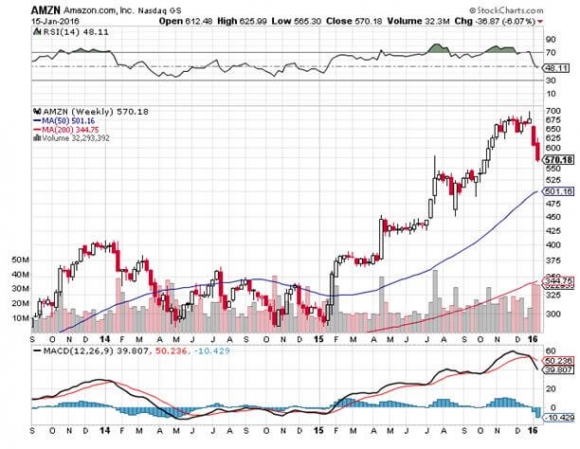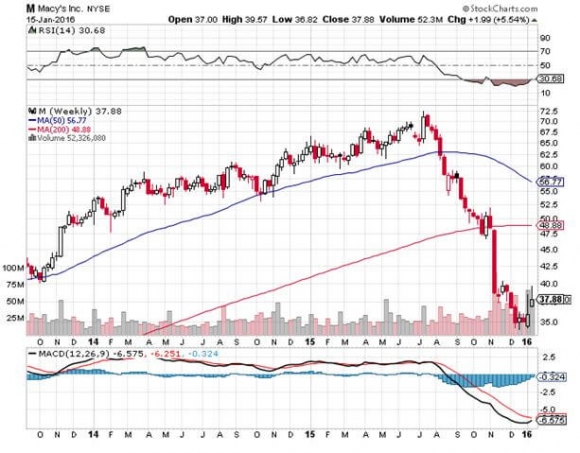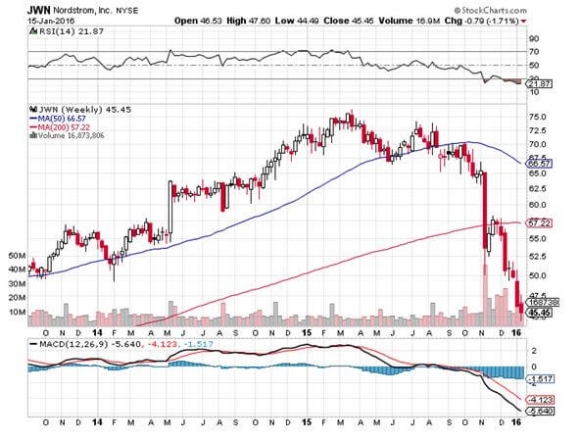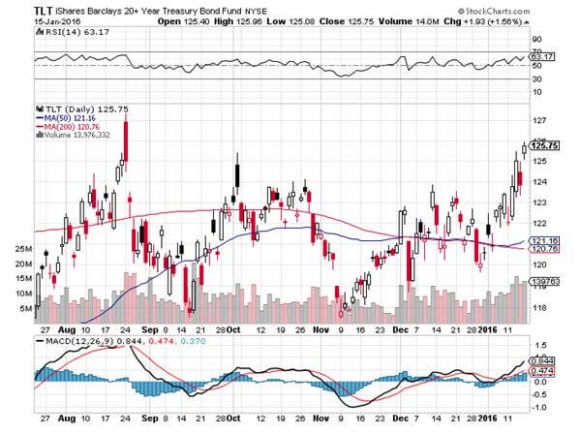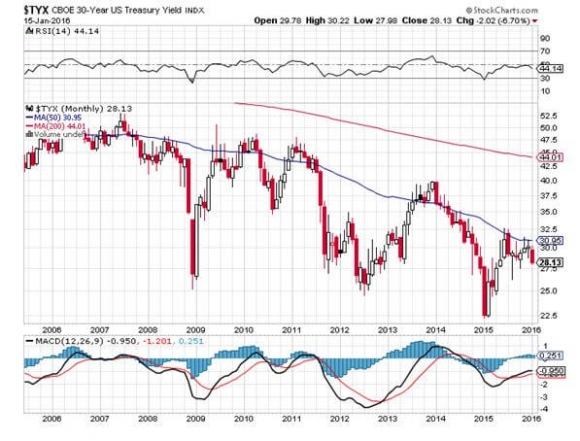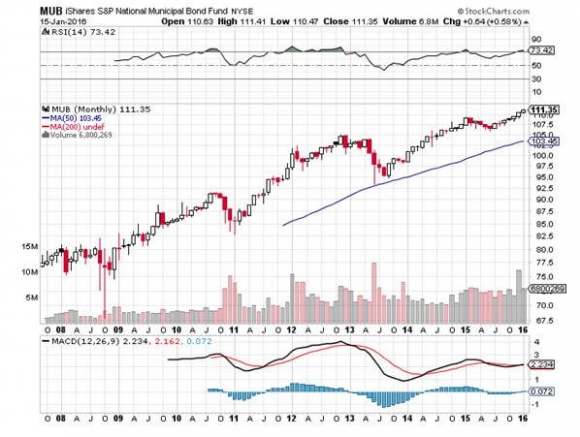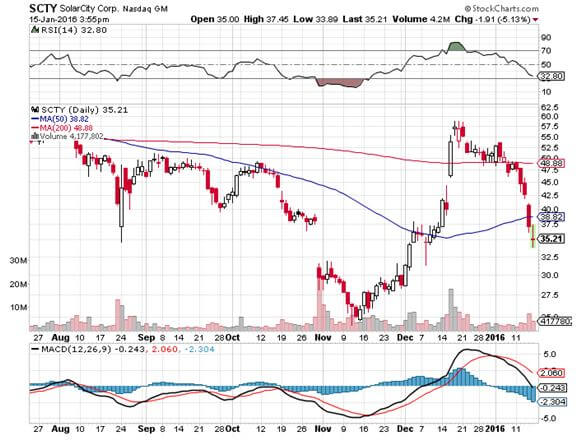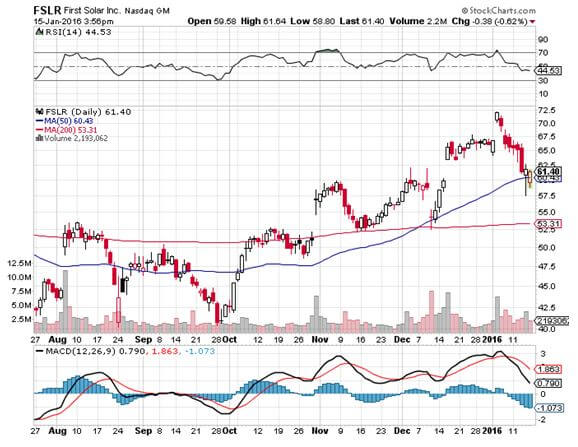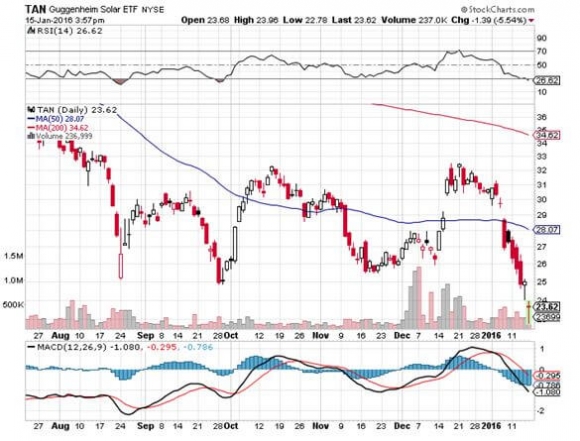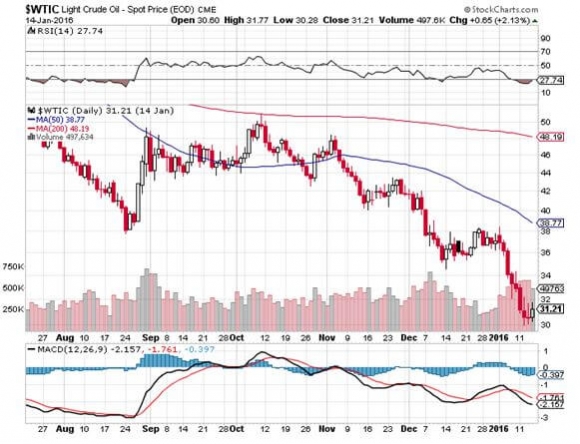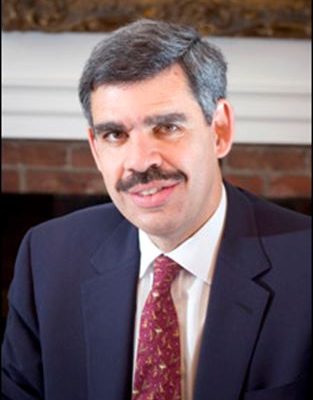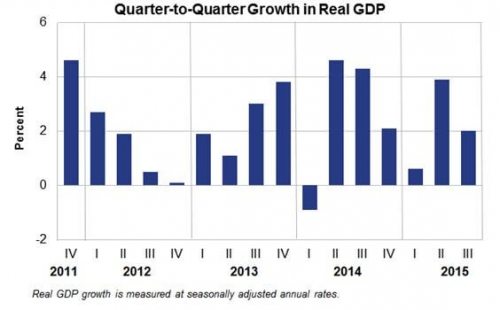
Global Market Comments
January 20, 2016
Fiat Lux
Featured Trade:
(THE DEATH OF RETAIL),
(WMT), (AMZN), (M), (JWN), (BBY), (BABA),
(THE 1% AND THE BOND MARKET),
(TLT), ($TYX), (LQD), (MUB), (JNK)
Wal-Mart Stores Inc. (WMT)
Amazon.com, Inc. (AMZN)
Macy's, Inc. (M)
Nordstrom Inc. (JWN)
Best Buy Co., Inc. (BBY)
Alibaba Group Holding Limited (BABA)
iShares Trust - iShares 20+ Year Treasury Bond ETF (TLT)
Treasury Yield 30 Years (^TYX)
iShares Trust - iShares iBoxx $ Investment Grade Corporate Bond ETF (LQD)
iShares National AMT-Free Muni Bond (MUB)
WisdomTree Trust - WisdomTree Emerging Markets Local Debt Fund (ELD)
SPDR Series Trust - SPDR Barclays High Yield Bond ETF (JNK)
I stopped at a Wal-Mart (WMT) the other day on my way to Napa Valley.
I am not normally a customer of this establishment. But I was on my way to a meeting where a dozen red long stem roses would prove useful. I happened to know you could get these for $10 at Wal-Mart.
After I found my flowers, I browsed around the store to see what else they had for sale. The first thing I noticed was that half the employees were missing their front teeth.
The clothing offered was out of style and made of cheap material. It might as well have been the Chinese embassy. Most concerning, there was almost no one there.
So I was not surprised when the company announced that it was closing 267 stores worldwide. The closures amount to only 1% of Wal-Mart?s total floor space. Some 10,000 American jobs will be lost.
The Wal-Mart downsizing is only the latest evidence of a major change in the global economy that has been evolving over the last two decades.
However, it now appears we have reached a tipping point, and a point of no return. The future is happening faster than anyone thought possible. Call it the Death of Retail.
I remember the first purchases I made at Amazon 20 years ago. The idea was so dubious that I made my initial purchases with a credit card with a low $1,000 limit. That way, if the wheels fell off, my losses would be limited.
This is despite the fact that I knew Jeff Bezos personally as a former Morgan Stanley colleague. And how stupid was that name, Amazon? At least he didn?t call it ?Yahoo?.
Today, I do almost all of my shopping at Amazon (AMZN). It saves me immense amounts of time while expanding my choices exponentially. And I don?t have to fight traffic, engage in the parking space wars, or wait in line to pay.
It can accommodate all of my requests, no matter how bizarre or esoteric. A WWII reproduction Army Air Corps canvas flight jacket in size XXL? No problem!
A used 42-inch Sub Zero refrigerator with a front door icemaker and water dispenser? Have it there in two days, with free shipping.
In 2000, after the great ?Y2K? disaster that failed to show, I met with Bill Gates Sr. to discuss the foundation?s investments. It turned out that they had liquidated their entire equity portfolio and placed all their money into bonds. It turned out to be a brilliant move, coming mere months before the Dotcom bust.
Mr. Gates (another Eagle Scout) mentioned something fascinating to me. He said that unlike most other foundations their size, they hadn?t invested a dollar in commercial real estate.
It was his view that the US economy would move entirely online, everyone would work from home, emptying out city centers and rendering commuting unnecessary. Shopping malls would become low rent climbing walls and paint ball game centers.
Mr. Gates? prediction may finally be occurring. Some counties in the San Francisco Bay area now see 25% of their workers telecommuting.
It is becoming common for staff to work Tuesday-Thursday at the office, and from home on Monday and Friday. Productivity increases. People are bending their jobs to fit their lifestyles. And oh yes, happy people work for less money in exchange for personal freedom, boosting profits.
The Mad Hedge Fund Trader itself may be a model for the future. We are entirely a virtual company, with no office. Everyone works at home across the country and around the world.
You may have noticed that I can work from anywhere and anytime (although sending a Trade Alert from the back of a camel in the Sahara Desert was a stretch).
The cost of global distribution is essentially zero. Profits go into a bonus pool shared by all. Oh, and we?re hiring, especially in marketing.
You can see this in the business prospects of traditional brick and mortar retailers last year, which were dire.
As a result, Macy?s (M) stock plunged by a shocking -53%, Nordstrom (JWN) by -43%, and Best Buy (BBY) by -39%. Value players have mistaken the present low prices and subterranean price earnings multiples for a ?Black Friday? sale.
It has been like leading lambs to the slaughter.
Yes, some of this was caused by record warm temperatures on the US East coast, which led many to cancel their purchases of a new winter coat. But it is also happening because the entire ?bricks and mortar? industry is getting left behind by the march of history.
Sure, they have been pouring millions into online commerce and jazzed up websites. But they all seem to be poor imitations of amazon, with higher prices. It is all ?Hour late and dollar short? stuff.
In the meantime, Amazon soared by 150%, and was one of the top performing stocks of 2015. It is thought that Amazon accounted for a staggering 25% of all the new growth in US retail sales last year.
And here is the bad news. Bricks and Mortar retailers are about to lose more of their lunch to Chinese Internet giant Alibaba (BABA), which is ramping up its US operations and is FOUR TIMES THE SIZE OF AMAZON!
There?s a good reason why you haven?t heard much from me about retailers. I made the decision 30 years ago never to touch the troubled sector.
I did this when I realized that management never knew beforehand which of their products would succeed, and which would bomb, and therefore were constantly clueless about future earnings.
The business for them was an endless roll of the dice. That is a proposition which I was unwilling to invest in. There were always better trades.
I confess that I had to look up the ticker symbols for this story, as I never use them.
However, I also missed the miracle at Amazon. I could never grasp their long tail strategy and their 100 X multiples. I have had to admire it from the sidelines. At least I wasn?t short.
You will no doubt be enticed to buy retail stocks as the deal of the century by the talking heads on TV, Internet research, and maybe even your own brokers.
It will be much like buying the coal industry (KOL) a few years ago, another industry headed for the dustbin of history. That was when ?cheap? was on its way to zero.
So the next time someone recommends that you buy retail stocks, you should probably lie down and take a long nap first. When you awaken, hopefully the temptation will be gone.
Or better yet, go shopping at Amazon. The deals are to die for.
To read ?An Evening with Bill Gates Sr.?, please click here.
 The Death of Retail?
The Death of Retail?
With the bond market confounding forecasters and prognosticators once again, I thought I?d delve into one of the more mysterious reasons why the bond market keeps going from strength to strength.
To a man, hedge fund traders expected bond prices to take a dive in 2014 and 2015 and for yields to soar. Isn?t that what?s supposed to happen in recovering economies?
Instead, we got the opposite, and yields have plunged, from 3.05% for the ten-year Treasury to as low as 2.80% this week.
There are many important lessons to be learned here. This is not your father?s bond market.
The internal dynamics of the fixed income markets have changed so much in the last three decades that it has become unrecognizable to long term practitioners, like myself.
A big factor has been the takeover of the bond market by the 1%, the richest segment of the US population and, indeed, the global economy. As wealth concentrates at the top, its character changes.
Let me stop here and tell you that the ultra rich are different from you and me, and not just because they have more money.
I have learned this after nearly half-century-long relationships with the planet?s wealthiest families, including the Rockefellers, Rothschilds, DuPonts, Morgans, and Pritzkers, first as important contacts of mine at The Economist, then as clients of mine at Morgan Stanley, then as investors in my hedge fund, and now as subscribers to The Diary of a Mad Hedge Fund Trader.
The wealthier families become the more conservative they get in their investment choices. Their goal shifts from capital appreciation to asset protection.
They lose interest in return on capital and become obsessed with return of capital. This is how the rich stay rich, sometimes for centuries. I have even noticed this among my newly minted billionaire hedge fund buddies.
What this means for the bond market is that they never sell. When they buy a 30-year Treasury bond, it is with the expectation of keeping it for the full 30 years until maturity.
That way they can avoid capital gains taxes and only have to pay taxes on the coupon interest. When they die, spouses get the step up in the cost basis, and then the wealth passes from one generation to the next. Taxes are never paid.
Back in the 1980s, when wealth was more evenly distributed, the top 1% only accounted for 1% of Treasury bond ownership. Today, that figure is closer to 25%.
Add this to the 50% of our national debt that is owned by foreign investors, primarily central banks, who also tend to hold paper for its full life. Central banks don?t pay taxes either.
China and Japan are the biggest holders with around $1 trillion each. This means that 75% or more of bonds are owned by investors who won?t sell. What does that mean for the rest of us? Bond prices that never go down.
With bonds very close to 30-year highs, keeping your bonds has been the right thing to do. I can?t tell you how many investment advisors I know who have distilled their practices down to managing fixed income instruments only.
This involves the entire coupon clipping space, including municipal bonds (MUB), corporates (LQD), junk (JNK), and even emerging market debt (ELD).
This is driven by customer demand, the 1%ers, not from any great insights or epiphanies they achieved on their own.
Of course, there is a certain amount of "driving with your eyes firmly fixed on the rear view mirror" going on here. Maybe the rich will finally sell their bonds once prices fall hard, stay down and then go down some more.
Inflation rearing its ugly head might also do the trick since it is always bad for bond prices as it reduces the purchasing power of money. Selling is certainly what they were doing in the early eighties, when the ten-year yield hit 12%.
Again, the rear view mirror effect, when bond were called ?certificates of wealth confiscation.?
There are other matters to consider with the 1% owning so much of the bond market and keeping it there.
This money is not getting invested in new start ups and creating jobs. It is money that is not being used to engender new economic growth. One of the fantasies of the last election was the claim that the 1% were creating so many jobs. They weren?t, not as long as their money was parked in a risk free bond market.
Instead, it is just stagnating. This is one reason why economic growth is so flaccid this decade and will remain so. This is fine for the 1%, but not so good for the rest of us.
The bottom line here is that while bonds are overbought and due for a pullback, they are not by any means going to crash. We could be living in the 2.60%-3.50% range for the 30-year for quite some time, maybe for years.
That is if the new Federal Reserve governor and my friend, ultra dove Janet Yellen, has anything to say about it. She has only just started and could be with us for another eight years.
Personally, I don?t foresee any appreciable rise in interest rates until we get well into the 2020s, when real inflation finally returns from the dead.
That is when bonds will become the asset class you don?t want to know, whether you?re in the 1% or not.
 Bonds Will Stay Up Until Inflation Returns from the Dead
Bonds Will Stay Up Until Inflation Returns from the Dead
Global Market Comments
January 19, 2016
Fiat Lux
Featured Trade:
(JANUARY 20 GLOBAL STRATEGY WEBINAR),
(THE GAME CHANGER FOR SOLAR),
(FSLR), (SPWR), (SCTY), (TAN),
(TESTIMONIAL),
(BREAKFAST WITH MOHAMED EL-ERIAN)
First Solar, Inc. (FSLR)
SunPower Corporation (SPWR)
SolarCity Corporation (SCTY)
Guggenheim Solar ETF (TAN)
With great fanfare, congress passed a blockbuster $1.8 trillion spending bill in December. President Obama hastily signed the bill into law the next day.
Barley noticed was a measure included in the bill, which extends the 30% investment tax credit for alternative energy investments by five more years, until the end of 2021.
Barely, that is, unless you owned solar stocks.
Since the intention to include this pet democratic program started leaking out in November, shares of the entire industry doubled in value.
Solar City (SCTY) rocketed by 136%. First Solar (FSLR) soared by 81%. Even the normally quiescent Guggenheim Solar ETF (TAN) gained an impressive 28%.
Since then, these shares have given up a big chunk of their gains, thanks to the ongoing stock market correction. Better look hard at this group. They could become one of the top performers this year.
In exchange for the solar extension, the president agreed to permit oil exports for the first time in 40 years. The fact that the country has run out of storage and already has 50 filled takers sitting offshore in the Gulf of Mexico makes this an easy move.
House Minority leader, Nancy Pelosi, my local congressperson, told me the republicans were willing to ?Give away the store? to get the export measure through.
It seems that the Koch Brothers, the republican party?s largest donors and funders of global warming deniers, wanted to use the oil export measure as the means to offshore the entire US petrochemical industry.
It is headed for emerging nations, where labor is cheaper, taxes are lower, and regulation nil. That means the loss of tens of thousands of US jobs, many in California, over which Pelosi complained.
Pelosi complaining about the loss of petrochemical jobs? It?s proof that if you live long enough, you see everything.
Whatever jobs the Golden State loses here, it will make back with solar, big time. Industry analysts estimate that the five-year extension is worth a STAGGERING $125 BILLION IN ADDITIONAL SALES!
That is a multiple of the entire solar industry?s current total annual sales.
What?s more, this is five years during which the solar industry can dramatically improve panel output efficiencies, inverters, designs, and cut costs (remember that the cost of labor and regulation, about half the cost of a solar installation, is still rising).
Solar is already close to grid parity on costs now. It is even competitive in Texas. It will be substantially cheaper in five years.
During the same time, the cost of grid power will keep rising continuously, thanks to rising capital cost of replacing aging infrastructure.
I?m not saying you should rush out and buy solar today. But when the bull market resumes later this year, this group should be at the top of your list.
As for me, I am already getting estimates for a doubling of my existing solar roof system to accommodate the charging of my second Tesla, the Model X.
To learn all the ins and outs of buying and installing a solar roof system for you self, please read ?How to Buy a Solar System? by clicking here.
 Better Bring Some More Panels
Better Bring Some More Panels
Thank you for talking with me on the phone right before Christmas.? I enjoyed our conversation and look forward to meeting you at your Incline Village Global Strategy Luncheon in the spring.?
I will also look forward to the hike up to 12,000 ft. after our lunch, (are you sure you want to spot me by carrying a 60 lbs pack?). I usually stop running at 12,000 just saying. LOL.?
Hope you are having a great day! I renewed today!
Greg B.
Colorado Springs, Colorado
 Winter Hiking at 12,000 Feet in the High Sierras
Winter Hiking at 12,000 Feet in the High Sierras
Passing through Los Angeles for a day, I thought I would take a walk down Nostalgia Lane and have breakfast at the historic Langham Huntington Hotel, the venue for my 1970 senior prom.
I was half way through my eggs Benedict in the Terrace Room when, who sits at the next table, but bond giant PIMCO?s brilliant former CEO and co-CIO, Mohamed El-Erian.
That?s the last time he makes that mistake. I proceeded to grill him on the long-term prospects for the global economy, in the politest way possible.
Mohamed anticipates ?a bumpy journey to a new normal.? Developed countries will see sluggish economic growth, high structural unemployment, increased regulation, and constant pressure for private sector deleveraging.
Emerging economies will maintain the breakout stage of their development phase. They will deliver high economic growth, strong currencies, and increasingly close the income gap with the developed world.
Policymakers have embraced initiatives designed to boost asset prices, divorcing them from economic fundamentals. The impact on Main Street has fallen well short of expectations. Interest rates have been repressed.
Mohamed thinks we will see an uneven and faltering economic recovery over the next five years. He is sticking with his long-term growth rate for the US of 2%. Investors face a particularly devilish challenge in that much of our past returns have already been borrowed from the future.
Inflation will return eventually. Commodity prices will rise. Yield curves will steepen. High dividend stocks will prosper. Many emerging market currencies will appreciate.
El-Erian has one of the best 90,000-foot views out there. A US citizen with an Egyptian father, he started out life at the old Salomon Smith Barney in London and went on to spend 15 years at the International Monetary Fund.
He joined PIMCO in 1999, and then moved on to manage the Harvard endowment fund. His last book, When Markets Collide, was voted by The Economist magazine as the best business book of 2008. He regularly makes the list of the world?s top thinkers. A lightweight Mohamed is not.
His final piece of advice? Engage in ?constructive paranoia? and structure your portfolio to take advantage of these changes, rather than fall victim to them.
Global Market Comments
January 15, 2016
Fiat Lux
Featured Trade:
(JANUARY 20 GLOBAL STRATEGY WEBINAR),
(THE MARKETS ARE NOT RIGGED)
(TESTIMONIAL)
Hi John,
I now have some great strategies, which are working well thanks to you. I just need to follow them, stop listening to others, and stick more to my own plan, and of course your research.
All the best for the festive season.
Dallas
Melbourne, Australia
 Hatchet Throwing Contest at Fort Vancouver, Washington
Hatchet Throwing Contest at Fort Vancouver, Washington
Global Market Comments
January 14, 2016
Fiat Lux
Featured Trade:
(WHY I DOUBLED MY SHORTS YESTERDAY),
(SPY), (XIV), (USO), (FXI),
(HOW TO TRADE THE FRIDAY OPTIONS EXPIRATION),
(SPY), (TLT)
SPDR S&P 500 ETF (SPY)
VelocityShares Daily Inverse VIX ST ETN (XIV)
United States Oil (USO)
iShares China Large-Cap (FXI)
iShares 20+ Year Treasury Bond (TLT)


